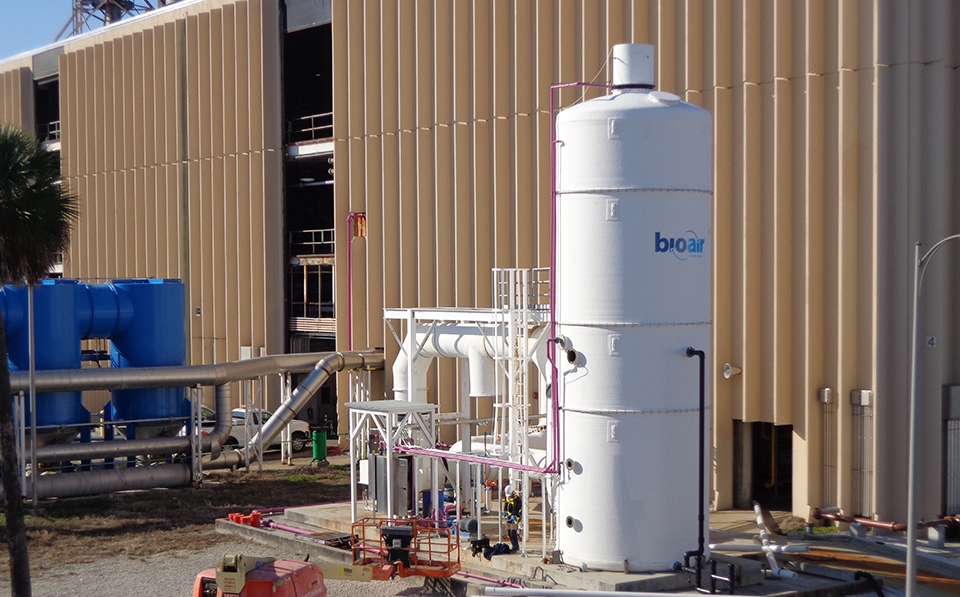
Identifying odour control needs in your manufacturing facility
October 5, 2017
By Timur Dunaev

Oct. 5, 2017 – Odour problems at manufacturing facilities can be unexpected, and can work against the production the facility is meant to accomplish. It starts out as a nuisance or a non-compliance issue, but can become a much bigger problem. Solving the problem requires analyzing how a facility’s processes generate and disperse odorous air, and then identifying an appropriate odour control solution.
The emission of odorous air is a fact of life across all industries — from food & beverage to paper production, and from oil & gas to pharmaceuticals.
Over the years, the problem has become familiar. As populations increase, residential developments creep closer and closer to industrial facilities that generate odours. Industrial facility leaders know they need to eliminate odours, but they often don’t know much more about how to do it.
Learning more about how odours are produced and the way they’re released can help these leaders make the right odour control decision for their site.
Examining industrial processes
Odour control experts must be dually knowledgeable in the mechanics of industrial processes and the science behind the odorous compounds generated in those processes.
These experts start their work by identifying the raw materials used in industrial processes, as well as the methods used in converting those materials to a finished product. Odours and non-odorous emissions are often produced when byproducts or waste is generated via those processes.
The facility’s process flow is also evaluated. Experts ask the following questions:
• What raw materials are used in the facility?
• What equipment and processes are used to convert raw materials?
• How are raw materials or products transported within the facility?
• What waste is generated during conversion?
• What odorous compounds are produced? How concentrated are these compounds in the air?
• At which points along the process flow are odours likely to escape?
Then, the expert evaluates how exposed neighbours are to offending odours.
Developing a solution
The information collected during the audit of a facility is used to design an odour control solution. The types and concentrations of odours emitted from a facility differ based on that facility’s application, but odour control solutions typically take the following forms:
• Activated carbon filters that trap odorous compounds and release clean air.
• Chemical filters or sprays that isolate and remove offending compounds from the air.
• Ozone systems that oxidize the odours, often followed by carbon polishing.
• Biofilters that force air through organic media harbouring microorganisms that get their energy by consuming odorous compounds.
• Bioscrubbers that send air through organic or synthetic media in a vessel. Microorganisms reside in recirculated water and use the odorous compounds in the air for food.
• Biotrickling filters, which feature microorganisms that reside within synthetic media. Irrigation water is only used to rinse metabolized compounds away. Water is not recirculated.
What to consider
With the variety of odour control solutions available to mitigate the variety of industrial odours, a facility’s owner or site manager needs to consider many factors that play into deciding on the odour control solution best suited for the site.
First, determine what resources are available on site. Limited access to water may mean bioscrubbers or biotrickling filters should be avoided. Mechanical resources matter, too. Ventilation schemes in some facilities may be better-suited for certain odour control solutions and may rule out others. Also, ventilation modifications could set the stage for a more effective odour control solution. Your odour control expert can help determine the best way forward.
Second, assess the scale of the odour issue in the facility. Your odour control expert will help you identify offending or harmful compounds, quantify the airflow carrying those compounds and determine how much of the odour should be removed.
Third, think about the amount of available space. If space is limited and neighbouring land is in development, a large biofilter may not be practical. Bioscrubbers and biotrickling filters are smaller but can typically handle airstreams with higher concentrations of odour than a biofilter. Conversely, if you have a lot of real estate to use and don’t have any close neighbours, a biofilter might be the best choice.
Finally, consider your maintenance personnel. The various odour control solutions on the market require various amounts of skill and manhours to maintain. Some even require workers to handle hazardous materials. Will you need to hire more maintenance staff or invest in additional training? Could you reduce that staff with a less labour-intensive odour control solution?
Your odour control expert should look at the entirety of your facility. Odour control is not about slapping treatment equipment down in each spot where odorous air is noticed, and in fact, this approach can prove to be far more expensive. Proper odour treatment requires a diligent survey of the inner workings of a plant with the goal of centralizing and then efficiently treating as much foul air as possible. This may mean a larger investment at first, but the result will be a reliable, effective, long-term odour control solution.
The right partner
Serious odour issues require a serious approach that attacks every angle of the problem. If your odour control expert doesn’t take the time to analyze your products and processes to tailor a solution that fits your site’s individual needs, find one who does. It could mean the difference between persisting nuisance odours and clean, odour-free air over the long term.
Timur Dunaev leads business development, process and research efforts for BioAir Solutions, focusing on holistic odour control. Prior to that, he worked in and managed process design and development for the industrial and municipal wastewater treatment industry for the first five years of his career.
Advertisement
- U.S. factory orders increase 1.2% in August
- Eastman Chemical: No health impact from plant explosions